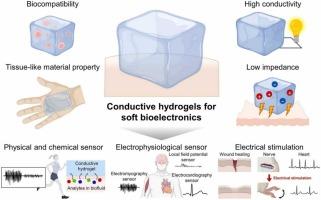导电性高分子水凝胶的合成、表征、传感器及其能量收集应用综述
IF 4.9
2区 化学
Q1 CHEMISTRY, ANALYTICAL
引用次数: 0
摘要
导电聚合物水凝胶(CPHs)是一种新型的杂化材料,它将导电聚合物的导电性与水凝胶的高含水量、柔韧性和柔软性相结合。这种独特的集成产生了多功能材料,具有下一代传感器和能量收集系统的巨大潜力。本文简要介绍了近年来CPHs的合成、表征和应用方面的进展,重点介绍了它们在柔性电子和能源器件中的作用。重点介绍了各种导电聚合物的选择及其在制备导电聚合物水凝胶中的性能,以及它们的表征技术。此外,还讨论了CPHs在传感器技术中的应用,包括可穿戴应变传感器、生物传感器和化学探测器。此外,CPHs在能量存储和收集设备中的作用,如超级电容器,电池和热电系统,都进行了检查。总之,这篇综述提供了一个全面的了解,cph作为有前途的材料,可持续和柔性的电子系统。本文章由计算机程序翻译,如有差异,请以英文原文为准。

A review of conducting polymer hydrogels: Synthesis and characterization, and their sensors, and energy harvesting applications
Conducting polymer hydrogels (CPHs) are a new type of hybrid material that combines the electrical conductivity of conducting polymers with the high water content, flexibility, and softness of hydrogels. This unique integration yields multifunctional materials with significant potential for next-generation sensors and energy harvesting systems. This review presents a concise overview of recent advancements in the synthesis, characterization, and application of CPHs, focusing on their roles in flexible electronics and energy devices. The choice of various conducting polymers and their properties in making conducting polymer hydrogels and their characterization techniques that are essential for evaluating CPHs are highlighted. Further, the applications of CPHs in sensor technologies, including wearable strain sensors, biosensors, and chemical detectors, have been discussed. In addition, the roles of CPHs in energy storage and harvesting devices, such as supercapacitors, batteries, and thermoelectric systems, are examined. Overall, this review provides a comprehensive understanding of CPHs as promising materials for sustainable and flexible electronic systems.
求助全文
通过发布文献求助,成功后即可免费获取论文全文。
去求助
来源期刊

Microchemical Journal
化学-分析化学
CiteScore
8.70
自引率
8.30%
发文量
1131
审稿时长
1.9 months
期刊介绍:
The Microchemical Journal is a peer reviewed journal devoted to all aspects and phases of analytical chemistry and chemical analysis. The Microchemical Journal publishes articles which are at the forefront of modern analytical chemistry and cover innovations in the techniques to the finest possible limits. This includes fundamental aspects, instrumentation, new developments, innovative and novel methods and applications including environmental and clinical field.
Traditional classical analytical methods such as spectrophotometry and titrimetry as well as established instrumentation methods such as flame and graphite furnace atomic absorption spectrometry, gas chromatography, and modified glassy or carbon electrode electrochemical methods will be considered, provided they show significant improvements and novelty compared to the established methods.
 求助内容:
求助内容: 应助结果提醒方式:
应助结果提醒方式:


